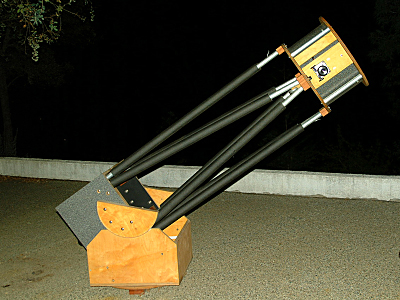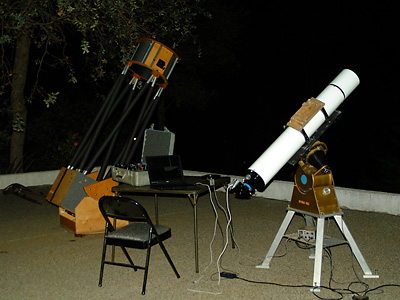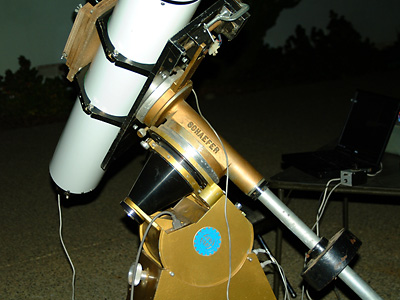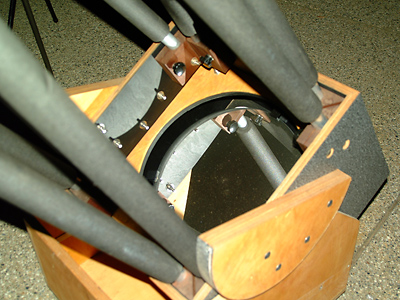 This
is a 16" Dobsonian reflector telescope. I built in in 1987 and it's still
in excellent condition throughout. The polished diameter is actually
16.25"; the focal length is 79.8", resulting in an f/4.9 focal ratio.
A fast focal ratio, f/5 or below, really brings out the wispy details of nebulae
and galaxies relative to the stars.
This
is a 16" Dobsonian reflector telescope. I built in in 1987 and it's still
in excellent condition throughout. The polished diameter is actually
16.25"; the focal length is 79.8", resulting in an f/4.9 focal ratio.
A fast focal ratio, f/5 or below, really brings out the wispy details of nebulae
and galaxies relative to the stars.
Interestingly,
the larger mirror increases the brightness of extended objects more than point
sources - such as stars.
 In
the foreground is an Astrophysics 6" f/8 refractor. It is on an
"equatorial mounting", which follows celestial objects by rotating the
telescope about the polar axis. You can see the polar axis pointed up at about a
40 degree angle due to the latitude where I typically observe.
In
the foreground is an Astrophysics 6" f/8 refractor. It is on an
"equatorial mounting", which follows celestial objects by rotating the
telescope about the polar axis. You can see the polar axis pointed up at about a
40 degree angle due to the latitude where I typically observe.
On
top of the telescope is a piggyback platform that holds a TeleVue Pronto, and a wide variety of
camera / lens setups.
 Here's
a closer look at the Byers 812 mount and the Schaefer declination assembly. You
can see the 40 degree inclination of the polar axis even though it's inside the
black cone. A trusty C-clamp holds my declination drive motor in place after I
accidentally stripped some threads. The large steel weight near the lower
end of the declination axis balances the telescope about the polar axis. Moving
the telescope end-to-end in the split-ring clamps adjust balance about the
declination axis.
Here's
a closer look at the Byers 812 mount and the Schaefer declination assembly. You
can see the 40 degree inclination of the polar axis even though it's inside the
black cone. A trusty C-clamp holds my declination drive motor in place after I
accidentally stripped some threads. The large steel weight near the lower
end of the declination axis balances the telescope about the polar axis. Moving
the telescope end-to-end in the split-ring clamps adjust balance about the
declination axis.
The circular part of the base can be tilted to match the location's latitude. A worm gear inside the
base drives a 30 degree segment of a 12" diameter tooth gear to achieve
smooth, reliable tracking.
 The
primary mirror of the reflecting telescope is almost 16.5" in diameter, of
which 16.25" are coated with aluminum that is 92% reflective. The flash
photograph makes it look like there is a lot of dust on the mirror. However, it
covers only a small percentage of the surface area and reduced the contrast of
the image only slightly. You can't see "specks of dust" looking
through the telescope.
The
primary mirror of the reflecting telescope is almost 16.5" in diameter, of
which 16.25" are coated with aluminum that is 92% reflective. The flash
photograph makes it look like there is a lot of dust on the mirror. However, it
covers only a small percentage of the surface area and reduced the contrast of
the image only slightly. You can't see "specks of dust" looking
through the telescope.
It's much better to
clean a mirror very occasionally, rather than risking a scratch in its
micro-thin reflective coating. About every 10 years, the aluminum needs to be
stripped and recoated. Even the mirrors of world-class observatories receive a
new coating every 5 to 10 years.
